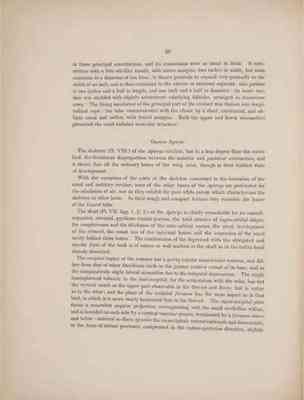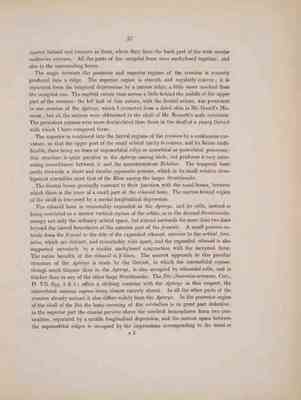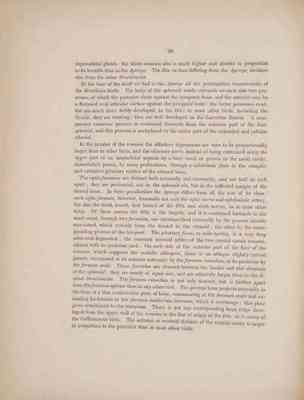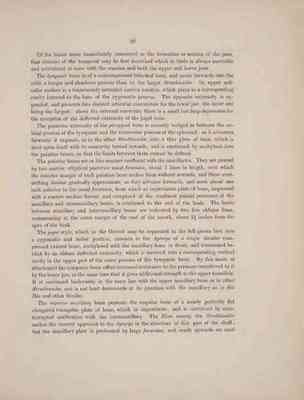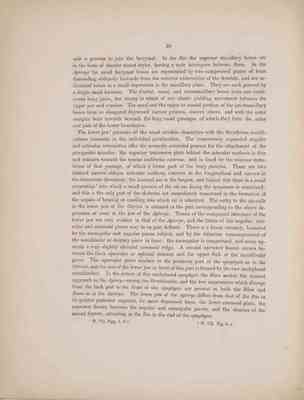Pages
46
26
in three principal convolutions, and its connexions were as usual in birds. It commences with a thin slit-like mouth, with entire margins, two inches in width, but soon contracts to a diameter of ten lines ; it thence proceeds to expand very gradually to the width of an inch, and is thus continued to the uterine or terminal segment : this portion is two inches and a half in length, and one inch and a half in diameter : its inner surface was studded with slightly arborescent calcifying follicles, arranged in transverse rows. the lining membrane of the principal part of the oviduct was thrown into longitudinal rugoe ; the tube communicated with the cloaca by a short, contracted, and oblique canal and orifice, with tumid margins. Both upper and lower mesometries presented the usual radiated muscular structure.
Osseous System
The skeleton (Pl. VIII.) of the Apteryx exhibits, but in a less degree than the entire bird, the Struthious disproportion between the anterior and posterior extremities, and it shows that all the ordinary bones of the wing exist, though in their feeblest state of development.
With the exception of the parts of the skeleton concerned in the formation of the nasal and auditory cavities, none of the other bones of the Apteryx are perforated for the admission of air, nor do they exhibit the pure white colour which characterizes the skeleton in other birds. In their tough and compact texture they resemble the bones of the Lizard tribe.
The skull (Pl. VII. figg. 1, 2, 5.) of the Apteryx is chiefly remarkable for its smooth, expanded, elevated, pyriform cranial portion, the total absence of supra-orbital ridges, the completeness and the thickness of the inter-orbital septum, the great development of the ethmoid, the small size of the lacrymal bones, and the expansion of the nasal cavity behind these bones. The combination of the depressed with the elongated and slender form of the beak is of course as well marked in the skull as in the entire head already described.
The occipital region of the cranium has a pretty regular semicircular contour, and differs from that of other Struthious birds in the greater relative extent of its base, and in the comparatively slight lateral sinuosities due to the temporal depressions. The single hemispherical tubercle in the basi-occipital, for the articulation with the atlas, has not the verical notch at the upper part observable in the Ostrich and Emeu, but is entire as in the Rhea ; and the plane of the occipital foramen has the same aspect as in that bird, in which it is more nearly horizontal than in the Ostrich. The supra-occipital plate forms a somewhat angular projection, corresponding with the small cerebellum within, and is bounded on each side by a vertical vascular groove, terminated by a foramen above and below : external to these grooves the ex-occipitals extend outwards and downwards, in the form of obtuse processes, compressed in the antero-posterior direction, slightly
47
27
convex behind and concave in front, where they form the back part of the wide meatus auditorius externus. All the parts of the occipital bone were anchylosed together, and also to the surrounding bones.
The angle between the posterior and superior regions of the cranium is scarcely produced into a ridge. The superior region is smooth and regularly convex ; it is separated from the temporal depressions by a narrow ridge, a little more marked than the occipital one. The sagittal suture runs across a little behind the middle of the upper part of the cranium : the left half of this suture, with the frontal suture, was persistent in one cranium of the Apteryx, which I extracted from a dried skin in Mr. Gould's Museum ; but all the sutures were obliterated in the skull of Mr. Bennett's male specimen. The persistent sutures were more denticulated than those in the skull of a young Ostrich with which I have compared them.
The superior is continued into the lateral regions of the cranium by a continuous curvature, so that the upper part of the small orbital cavity is convex and its limits undefinable, there being no trace of supraorbital ridge or antorbital or postorbital processes : this structure is quite peculiar to the Apteryx among birds, but produces a very interesting resemblance between it and the monotrematous Echidna. The temoral bone sends forwards a short and slender zygomatic process, which in its small relative development resembles most that of the Rhea among the larger Struthionidae.
The frontal bones gradually contract to their junction with the nasal bones, between which there is the trace of a small part of the ethmoid bone. The narrow frontal region of the skull is traversed by a mesial longitudinal depression.
The ethmoid bone is remarkably expanded in the Apteryx, and its cells , instead of being restricted to a narrow vertical septum of the orbits, as in the diurnal Struthionidae, occupy not only the ordinary orbital space, but extend outwards for more than two lines beyond the lateral boundaries of the anterior part of the frontals. A small process extends from the frontal to the side of the expanded ethmoid, anterior to the orbital foramina, which are distinct, and remarkably wide apart, and the expanded ethmoid is also supported anteriorly by a similar anchylosed conjunction with the lacrymal bone, The entire breadth of the ethmoid is 9 lines. The nearest approach to this peculiar structure of the Apteryx is made by the Ostrich, in which the interorbital septum, though much thinner than in the Apteryx, is also occupied by ethmoidal cells, and is thicker than in any of the other large Struthionidae. the Ibis (Numenius arcuatus, Cuv., Pl. VII. figg. 3 & 4.) offers a striking contrast with the Apteryx in this respect, the interorbital osseous septum being almost entirely absent. In all the other parts of the cranium already noticed it also differs widely from the Apteryx. In the posterior region of the skull of the Ibis the bony covering of the cerebellum is in great part defective : in the superior part the cranial parietes above the cerebral hemispheres form two convexities, separated by a middle longitudinal depression, and the narrow space between the supraorbital ridges is occupied by the impressions corresponding to the nasal or
E 2
48
28
supraorbital glands : the whole cranium is much higher and shorter in proportion to its breadth than in the Apteryx. The Ibis, in thus differing from the Apteryx, deviates also from the other Struthionidoe.
At the base of the skull we find in the Apteryx all the peculiarities characteristic of the Struthious birds. The body of the sphenoid sends outwards on each side two processes, of which the posterior abuts against the tympanic bone : the latter processes exist, but are much more feebly developed, in the Ibis : in most other birds, including the Gralloe, they are wanting : they are well developed in the Lacertine Sauria. A compressed vomerine process is anchylosed to the under part of the expanded and cellular ethmoid.
In the interior of the cranium the olfactory depressions are seen to be proportionally larger than in other birds, and the olfactory nerve, instead of being continued along the upper part of an interorbital septum by a bony canal or groove to the nasal cavity, immediately passes, by many perforations, through a cribriform plate to the complex and extensive pituitary surface of the ethmoid bone.
The optic foramina are distinct both internally and externally, and are half an inch apart ; they are perforated, not in the sphenoid ala, but in the inflected margin of the frontal bone. In these peculiarities the Apteryx differs from all the rest of its class : each optic foramen, however, transmits not only the optic nerve and ophthalmic artery, but also the third, fourth, first branch of the fifth and sixth nerves, as in most other birds. Of these nerves the fifth is the largest, and it is continued forwards to the nasal canal, through two foramina, one circumscribed externally by the process already mentioned, which extends from the frontal to the ethmoid ; the other by the corresponding process of the lacrymal. the pituitary fossa, or sella turcica, is a very deep semi-oval depression ; the common internal orifice of the two carotid canals communicates with its posterior part. On each side of the anterior part of the floor of the cranium, which supports the medulla oblongata, there is an oblique slightly curved groove, terminated at its anterior extremity by the foramen rotundum, at its posterior by the foramen ovale. These foramina are situated between the basilar and alar elements of the spenoid ; they are nearly of equal size, and are relatively larger than in the diurnal Struthionidoe. The foramen rotundum is not only distinct, but is further apart from the foramen opticum than in any other bird. The petrous bone projects internally in the form of a thin semicircular plate of bone, commencing at the foramen ovale and extending backwards to the foramen auditorium internum, which it overhangs : this plate gives attachment to the tentorium. There is not any corresponding bony ridges developed from the upper wall of the cranium in the line of origin of the falx, as in many of the Gallinaceous birds. The anterior or cerebral division of the cranial cavity is larger in proportion to the posterior than in most other birds.
49
29
Of the bones more immediately concerned in the formation or motion of the jaws, that element of the emporal may be first described which in birds is always moveable and articulated at once with the cranium and both the upper and lower jaws.
The tympanic bone is of a subcompressed trihedral form, and sends forwards into the orbit a longer slenderer process than in the larger Struthionidoe : its upper articular surface is a transversely extended convex condyle, which plays in a corresponding cavity internal to the base of the zygomatic process. The opposite extremity is expanded, and presents two distinct articular convexities for the lower jaw, the inner one being the largest : above the external convexity there is a small but deep depression for the reception of the deflected extremity of the jugal bone.
The posterior extremity of the pterygoid bone is securely wedged in between the orbital process of the tympanic and the transverse process of the sphenoid : as it advances forwards it expands, as in the other Struthionidoe, into a thin plate of bone, which is bent upon itself with its concavity turned inwards, and is continued by anchylosis into the palatine bones, so that the limits between them cannot be defined.
The palatine bones are in like manner confluent with the maxillaries. They are pierced by two narrow elliptical posterior nasal foramina, about 3 lines in length, over which the exterior margin of each palatine bone arches from without inwards, and these overarching laminoe gradually approximate, as they advance forwards, and meet about one inch anterior to the nasal foramina, from which an imperforate plate of bone, impressed with a narrow median fissure, and composed of the confluent palatal processes of the maxillary and intermaxillary bones, is continued to the end of the beak. the limits between maxillary and intermaxillary bones are indicated by two fine oblique lines, commencing at the outer margin of the roof of the mouth, about 2 1/2 inches from the apex of the beak.
The jugal style, which in the Otrich may be separated in the full-grown bird into a zygomatic and malar portion, consists in the Apteryx of a single slender compressed twisted bone, anchylosed with the maxillary bone in front, and terminated behind by an obtuse deflected extremity, which is received into a corresponding vertical cavity in the upper part of the outer process of the tympanic bone. By this mode of attachment the sympanic bone offers increased resistance to the pressure transferred to it by the lower jaw, at the same time that it gives additional strength to the upper mandible. It is continued backwards in the same line with the upper maxillary bone as in other Struthionidoe, and is not bent downwards at its junction with the maxillary as in the Ibis and Gralloe.
The superior maxillary bone presents the singular form of a nearly perfectly flat elongated triangular plate of bone, which is imperforate, and is continued by uninterrupted ossification with the intermaxillary. The Rhea among the Struthionidoe makes the nearest approach to the Apteryx in the structure of this part of the skull : but the maxillary plate is perforated by large foramina, and sends upwards on each
50
30
side a process to join the lacrymal. In the Ibis the superior maxillary bones are in the form of slender round styles, having a wide interpsace between them. In the Apteryx the small lacrymal bones are respresented by two compressed plates of bone descending obliquely forwards from the anterior extremities of the frontals, and are articulated below to a small depression in the maxillary plate. They are each pierced by a single small foramen. The frontal, nasal, and intermaxillary bones form one continuous bony piece, too strong to admit of any elastic yielding movement between the upper jaw and cranium. The nasal and the upper or mesial portion of the intermaxillary bones form an elngated depressed narrow process, convex above, and with the outer margins bent inwards beneath the long nasal passages, of which they form the outer and part of the lower boundaries.
The lower jaw 1 presents all the usual ornithic characters with the Struthious modifications traceable in the individual peculiarities. The transversely expanded angular and articular extremities offer the inwardly extended process for the attachment of the pterygoidei muscles : the superior transverse plate behind the articular surfaces is thin and concave towards the meatus auditorius externus, and is lined by the mucous membrane of that passage, of which it forms part of the bony parietes. There are two distinct narrow oblique articular surfaces, concave in the longitudinal and convex in the transverse direction ; the internal is the largest, and behind this there is a small excavation 2 into which a small process of the air-sac lining the tumpanum is continued ; and this is the only part of the skeleton not immediately concerned in the formation of the organs of hearing or smelling into which air is admitted. The entry to the air-cells in the lower jaw of the Ostrich is situated in the part corresponding to the above depression or sinus in the jaw of the Apteryx. Traces of the compound structure of the lower jaw are very evident in that of the Apteryx, and the limits of the angular, articular and coronoid pieces may be in part defined. There is a linear vacancy, bounded by the surangular and angular pieces behind, and by the difurcate commencement of the mandibular or dentary piece in front : the surangular is compressed, and sends upwards a very slightly elevated coronoid ridge. A second narrower fissure occurs between the thick opercular or splenial element and the upper fork of the mandibular piece. the opercular piece reaches to the posterior part of the sumphysis as in the Ostrich, and the rest of the lower jaw in front of this part is formed by the two anchylosed mandibulars. In the extent of this anchylosed symphysis the Rhea makes the nearest approach to the Apteryx among the Struthionidoe, and the two impressions which diverge from the back part to the front of the symphysis are present in both the Rhea and Emeu as in the Apteryx. the lower jaw of the Apteryx differs from that of the Ibis in its greater posterior expanse, its more depressed form, the lower coronoid plate, the narrower fissure between the angular and surangular pieces, and the absence of the mesial furrow, extending in the Ibis to the end of the symphysis.
1 Pl. VII. Figg. 6 & 7. 2. Pl. VII. Fig. 6.a.
